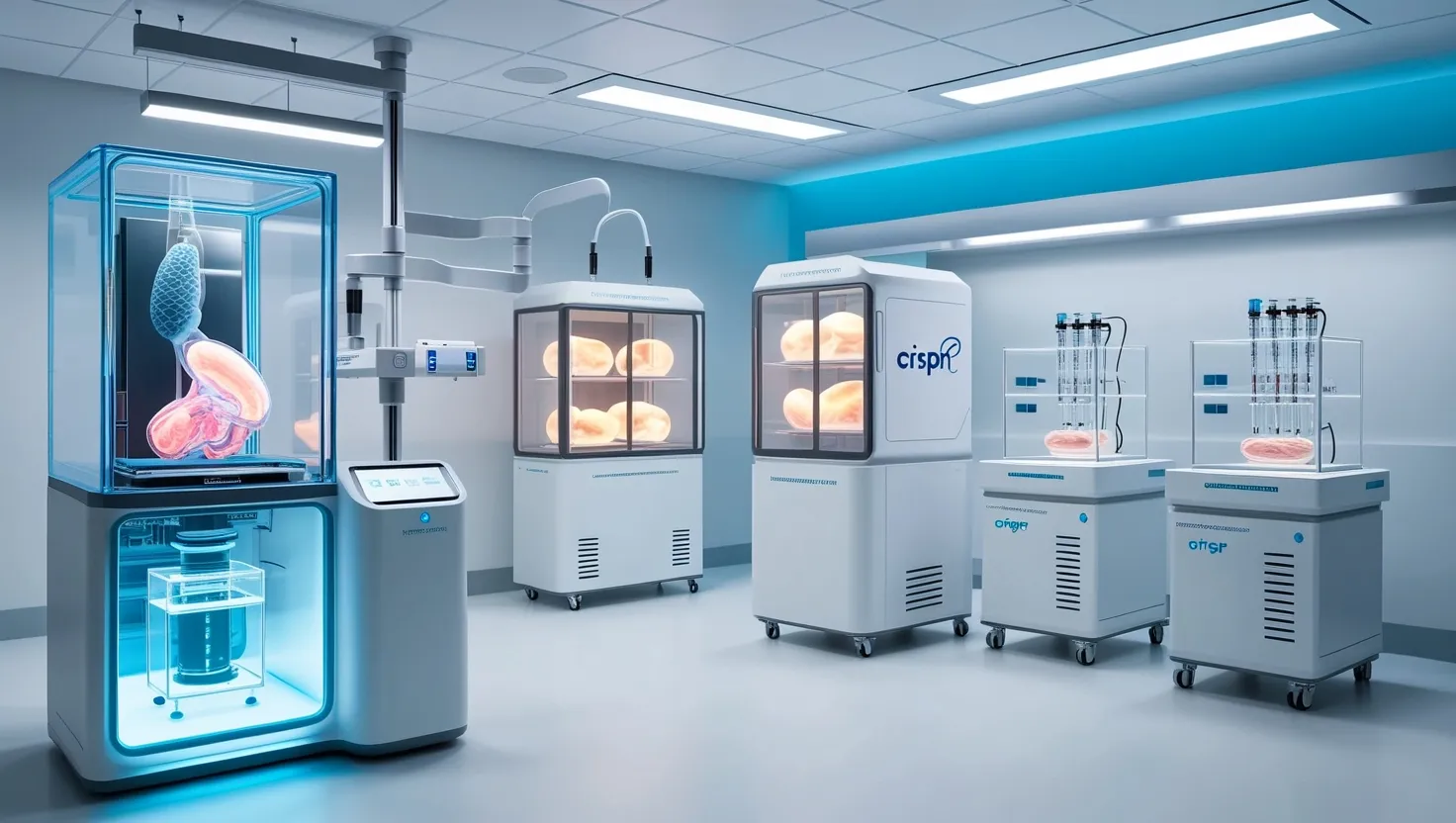The world of organ transplantation is on the cusp of a revolution. As we stand at the intersection of biology and technology, groundbreaking innovations are reshaping the landscape of this life-saving medical field. Let’s explore six radical technologies that promise to transform organ transplantation as we know it.
Imagine a world where we can edit the genetic code of animal organs to make them compatible with human bodies. This is no longer science fiction, thanks to CRISPR gene-editing technology. By precisely modifying pig organs, scientists are creating a potentially unlimited supply of transplantable organs that the human immune system won’t reject. It’s like giving nature’s blueprint a careful rewrite, erasing the parts that cause problems and adding in helpful human genes.
But why stop at modifying existing organs when we can print new ones from scratch? 3D bioprinting is turning this wild idea into reality. Using a patient’s own stem cells as ink, these printers can create fully compatible organs layer by layer. Picture a heart, kidney, or liver being built to order, with blood vessels and all, perfectly matched to the recipient. No more waiting lists, no more rejection risks – just a tailor-made organ ready when needed.
What if we could keep organs fresh for days instead of hours? New organ preservation techniques are making this possible. By supercooling organs and perfusing them with special solutions, we can extend their viability far beyond current limits. This breakthrough could revolutionize organ allocation, allowing perfect matches to be found across vast distances. Imagine an organ harvested in New York being transplanted in California days later, still in prime condition.
Have you ever wondered what it would be like to have an organ with a built-in computer? Artificial organs with embedded microprocessors are turning this sci-fi concept into reality. These smart organs can mimic natural functions while constantly monitoring and adapting to the body’s needs. They’re like tiny, tireless doctors living inside you, always on call to keep everything running smoothly.
But what about organs that are damaged or less than perfect? Ex vivo organ repair platforms are giving these organs a second chance at life. By treating organs outside the body with targeted gene therapy and stem cells, we can rejuvenate and repair damage, dramatically expanding the pool of usable donor organs. It’s like a spa day for organs, sending them back into service refreshed and renewed.
Lastly, let’s talk about personalized medicine taken to the extreme. Organ-on-chip systems allow doctors to test medications and predict rejection risks on a tiny model of a patient’s organ before transplantation. Imagine being able to fine-tune your anti-rejection medication regimen before the transplant even happens. It’s like having a crystal ball for transplant outcomes, helping ensure the best possible chance of success.
These technologies are not just incremental improvements – they represent a paradigm shift in how we approach organ transplantation. They promise to address the most pressing challenges in the field: organ availability, compatibility, and longevity. With these innovations, we could see a future where no one dies waiting for an organ, where rejection is a thing of the past, and where transplanted organs last a lifetime.
But as we marvel at these technological wonders, we must also grapple with the ethical implications they bring. How do we ensure equitable access to these potentially life-saving technologies? What are the long-term effects of genetically modified organs in human bodies? How do we balance the promise of artificial organs with the sanctity of natural human biology?
As the renowned transplant surgeon Thomas E. Starzl once said, “The field of transplantation is a testament to the heights that can be achieved when human ingenuity and compassion work in concert.” These new technologies embody that spirit, pushing the boundaries of what’s possible in our quest to save lives.
What do you think about these innovations? Which one excites you the most? How do you envision these technologies changing the future of medicine?
As we look to this bright future, it’s important to remember that these technologies are still in various stages of development. Some, like CRISPR-engineered organs and advanced preservation techniques, are already being tested in clinical trials. Others, like fully functional 3D bioprinted organs, are still years away from practical use. But the pace of progress is accelerating, and breakthroughs are happening faster than ever before.
Consider the potential impact on global health. Currently, thousands of people die each year waiting for organ transplants. These technologies could eliminate waiting lists entirely, saving countless lives. They could also make transplantation a viable option for conditions that currently have no cure, expanding the horizons of what’s treatable in medicine.
But it’s not just about quantity – it’s about quality too. These innovations promise to improve the outcomes of transplantation dramatically. With personalized organ-on-chip testing and smart artificial organs, we could see a future where organ rejection becomes rare, and transplanted organs function better and last longer than ever before.
The economic implications are also profound. While the initial costs of developing and implementing these technologies are high, they could ultimately lead to significant savings in healthcare. Imagine reducing or eliminating the need for lifelong immunosuppression drugs, or the cost savings from not having to re-transplant organs that fail.
As we stand on the brink of this new era in transplantation, it’s worth pondering: How will these technologies change the way we think about our bodies and our health? Will we see a future where organ replacement becomes as routine as getting a vaccine?
The pioneering transplant surgeon Christiaan Barnard once said, “The prime goal is to alleviate suffering, and not to prolong life. And if your treatment does not alleviate suffering, but only prolongs life, that treatment should be stopped.” These new technologies align perfectly with this ethos, not just prolonging life, but improving its quality.
As we continue to push the boundaries of what’s possible in organ transplantation, we must remain mindful of the human element at the core of this field. Behind every technological advance are real people – patients waiting for a second chance at life, donors and their families making the ultimate gift, and dedicated medical professionals working tirelessly to save lives.
What role do you think society should play in guiding the development and implementation of these technologies? How can we ensure that these advancements benefit all of humanity, not just those who can afford them?
In conclusion, the future of organ transplantation is bright, filled with promise and potential. These six radical technologies – CRISPR-engineered organs, 3D bioprinting, advanced preservation techniques, smart artificial organs, ex vivo repair platforms, and organ-on-chip systems – are set to transform the field in ways we’re only beginning to understand. They offer hope to millions of patients worldwide and open up new frontiers in medical science.
As we move forward into this exciting new era, let’s embrace these innovations with open minds and careful consideration. The power to reshape human health is in our hands. How will we use it?






